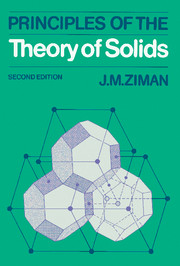Book contents
- Frontmatter
- PREFACE
- PREFACE TO THE SECOND EDITION
- Contents
- Chapter 1 Periodic Structures
- Chapter 2 Lattice Waves
- Chapter 3 Electron States
- Chapter 4 Static Properties of Solids
- Chapter 5 Electron-Electron Interaction
- Chapter 6 Dynamics of Electrons
- Chapter 7 Transport Properties
- Chapter 8 Optical Properties
- Chapter 9 The Fermi Surface
- Chapter 10 Magnetism
- Chapter 11 Superconductivity
- Bibliography
- Index
- Frontmatter
- PREFACE
- PREFACE TO THE SECOND EDITION
- Contents
- Chapter 1 Periodic Structures
- Chapter 2 Lattice Waves
- Chapter 3 Electron States
- Chapter 4 Static Properties of Solids
- Chapter 5 Electron-Electron Interaction
- Chapter 6 Dynamics of Electrons
- Chapter 7 Transport Properties
- Chapter 8 Optical Properties
- Chapter 9 The Fermi Surface
- Chapter 10 Magnetism
- Chapter 11 Superconductivity
- Bibliography
- Index
Summary
For those well ordered motions, and regular paces, though they give no sound unto the ear, yet to the understanding they strike a note most full of harmony.
SIR THOMAS BKOWNELattice dynamics
The simplest solid is probably solid argon, which is a regular array of neutral atoms, with tightly bound closed shells of electrons, held together by van der Waals forces, which act mainly between nearest neighbours in the lattice. The physics of such a crystal is the thermal motion of the atoms about their idealized equilibrium positions.
To discuss this motion the most elementary idea is the Einstein model, in which each atom vibrates like a simple harmonic oscillator in the potential well of the force fields of its neighbours. This field can never be precisely a quadratic well with spherical symmetry, but this is a reasonable approximation on the average. The excitation spectrum of the crystal then consists of levels spaced a distance ħVE apart, where vE is the Einstein frequency, i.e. the frequency of oscillation of each atom in its potential well.
This model is useful in some contexts where a very crude account of thermal vibrations is sufficient—especially at relatively high temperatures, when the assumption that the various atoms vibrate independently is justified. But we can see at once that if two or more atoms move in unison the forces between them, tending to restore each of them to its equilibrium position, will be reduced, so that the energy required to excite a quantum may be rather less. There is a tendency for the motion of the adjacent atoms to be correlated.
- Type
- Chapter
- Information
- Principles of the Theory of Solids , pp. 27 - 76Publisher: Cambridge University PressPrint publication year: 1972



